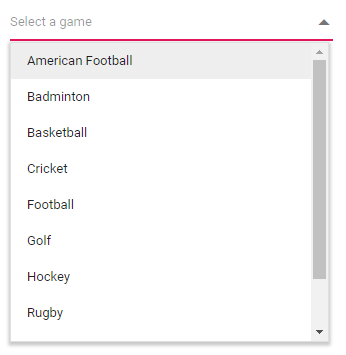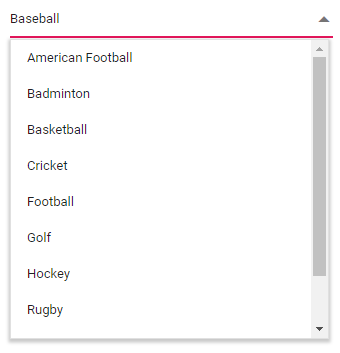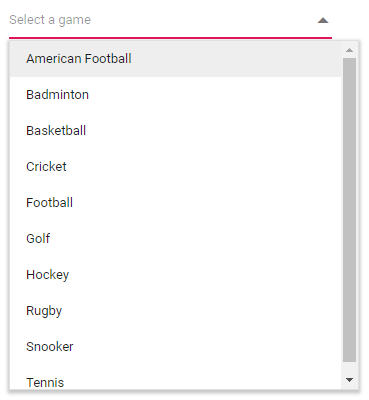Getting Started with Blazor ComboBox Component
4 Nov 20257 minutes to read
This section explains how to include the Blazor ComboBox component in a Blazor WebAssembly app using Visual Studio and Visual Studio Code.
To get started quickly with the Blazor ComboBox component, review the following video or the GitHub sample.
Prerequisites
Create a new Blazor App in Visual Studio
Create a Blazor WebAssembly App using Visual Studio via Microsoft templates or the Syncfusion® Blazor Extension.
Install Syncfusion® Blazor DropDowns and Themes NuGet in the App
To add the Blazor ComboBox component to the app, open the NuGet Package Manager in Visual Studio (Tools → NuGet Package Manager → Manage NuGet Packages for Solution), then search for and install Syncfusion.Blazor.DropDowns and Syncfusion.Blazor.Themes. Alternatively, use the following Package Manager commands.
Install-Package Syncfusion.Blazor.DropDowns -Version 31.2.12
Install-Package Syncfusion.Blazor.Themes -Version 31.2.12NOTE
Syncfusion® Blazor components are available on nuget.org. Refer to the NuGet packages topic for the complete list of packages and component details.
Prerequisites
Create a new Blazor App in Visual Studio Code
Create a Blazor WebAssembly App using Visual Studio Code via Microsoft Templates or the Syncfusion® Blazor Extension.
Alternatively, create a WebAssembly application using the following command in the terminal (Ctrl+`).
dotnet new blazorwasm -o BlazorApp
cd BlazorAppInstall Syncfusion® Blazor DropDowns and Themes NuGet in the App
- Press Ctrl+` to open the integrated terminal in Visual Studio Code.
- Ensure you are in the project root directory where the
.csprojfile is located. - Run the following commands to install Syncfusion.Blazor.DropDowns and Syncfusion.Blazor.Themes, and restore dependencies.
dotnet add package Syncfusion.Blazor.DropDowns -v 31.2.12
dotnet add package Syncfusion.Blazor.Themes -v 31.2.12
dotnet restoreNOTE
Syncfusion® Blazor components are available on nuget.org. Refer to the NuGet packages topic for the complete list of packages and component details.
Register Syncfusion® Blazor Service
Open the ~/_Imports.razor file and import the Syncfusion.Blazor and Syncfusion.Blazor.DropDowns namespaces.
@using Syncfusion.Blazor
@using Syncfusion.Blazor.DropDownsNow, register the Syncfusion® Blazor Service in the ~/Program.cs file of the Blazor WebAssembly App.
using Microsoft.AspNetCore.Components.Web;
using Microsoft.AspNetCore.Components.WebAssembly.Hosting;
using Syncfusion.Blazor;
var builder = WebAssemblyHostBuilder.CreateDefault(args);
builder.RootComponents.Add<App>("#app");
builder.RootComponents.Add<HeadOutlet>("head::after");
builder.Services.AddScoped(sp => new HttpClient { BaseAddress = new Uri(builder.HostEnvironment.BaseAddress) });
builder.Services.AddSyncfusionBlazor();
await builder.Build().RunAsync();
....Add stylesheet and script resources
The theme stylesheet and script are provided via NuGet using Static Web Assets. Add the stylesheet and script references to the <head> section of ~/index.html.
<head>
....
<link href="_content/Syncfusion.Blazor.Themes/bootstrap5.css" rel="stylesheet" />
<script src="_content/Syncfusion.Blazor.Core/scripts/syncfusion-blazor.min.js" type="text/javascript"></script>
</head>NOTE
See the Blazor Themes topic for various methods (Static Web Assets, CDN, and CRG) to reference themes. See Adding Script Reference for ways to add script references in a Blazor application.
Add Blazor ComboBox component
Add the Syncfusion Blazor ComboBox component in ~/Pages/Index.razor.
<SfComboBox TValue="string" TItem="string" Placeholder="Select a game"></SfComboBox>- Press Ctrl+F5 (Windows) or ⌘+F5 (macOS) to launch the application. This will render the Syncfusion® Blazor ComboBox component in your default web browser.

Binding data source
After initialization, populate the ComboBox with data using the DataSource property. In the following example, a list of objects (with ID and Text fields) is bound to the ComboBox.
<SfComboBox TValue="string" TItem="Games" Placeholder="Select a game" DataSource="@LocalData">
<ComboBoxFieldSettings Value="ID" Text="Text"></ComboBoxFieldSettings>
</SfComboBox>
@code {
public class Games
{
public string ID { get; set; }
public string Text { get; set; }
}
List<Games> LocalData = new List<Games> {
new Games() { ID= "Game1", Text= "American Football" },
new Games() { ID= "Game2", Text= "Badminton" },
new Games() { ID= "Game3", Text= "Basketball" },
new Games() { ID= "Game4", Text= "Cricket" },
new Games() { ID= "Game5", Text= "Football" },
new Games() { ID= "Game6", Text= "Golf" },
new Games() { ID= "Game7", Text= "Hockey" },
new Games() { ID= "Game8", Text= "Rugby"},
new Games() { ID= "Game9", Text= "Snooker" },
new Games() { ID= "Game10", Text= "Tennis"},
};
}
Custom values
The ComboBox supports custom values that are not present in the predefined list. This behavior is enabled by the AllowCustom property. In this mode, the typed text is treated as both the display text and the value, and the custom value is posted with the form on submit.
<SfComboBox TValue="string" TItem="Games" AllowCustom=true Placeholder="Select a game" DataSource="@LocalData">
<ComboBoxFieldSettings Value="ID" Text="Text"></ComboBoxFieldSettings>
</SfComboBox>
Configure the popup list
By default, the popup list width automatically adjusts to the ComboBox input width, and the popup height is 350px. The height and width of the popup list can be customized using the PopupHeight and PopupWidth properties.
<SfComboBox TValue="string" TItem="Games"PopupHeight="350px" PopupWidth="350px" Placeholder="Select a game" DataSource="@LocalData">
<ComboBoxFieldSettings Value="ID" Text="Text"></ComboBoxFieldSettings>
</SfComboBox>